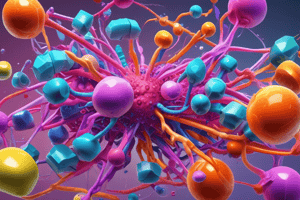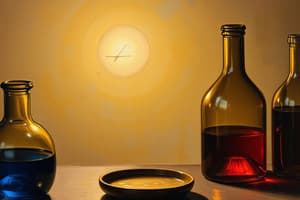Podcast
Questions and Answers
Which pharmacokinetic factor is most crucial for a drug to cross cell membranes directly?
Which pharmacokinetic factor is most crucial for a drug to cross cell membranes directly?
- Hydrophilicity
- pH of the surrounding fluid
- Lipid solubility (correct)
- Molecular weight
How do basic drugs behave in an acidic environment based on ion trapping?
How do basic drugs behave in an acidic environment based on ion trapping?
- They accumulate on the acidic side (correct)
- They ionize and accumulate on the basic side
- They remain uncharged
- They are rapidly excreted
What is the primary role of P-glycoprotein in pharmacokinetics?
What is the primary role of P-glycoprotein in pharmacokinetics?
- Facilitating drug absorption into the bloodstream
- Transporting drugs into liver cells for metabolism
- Transporting drugs out of cells to decrease drug accumulation (correct)
- Breaking down drugs into inactive metabolites
What occurs when the pH of the fluid on one side of a membrane is different from the other side?
What occurs when the pH of the fluid on one side of a membrane is different from the other side?
Which statement about acid drugs in basic environments is accurate?
Which statement about acid drugs in basic environments is accurate?
In which body organ does P-glycoprotein transport drugs into the bile for elimination?
In which body organ does P-glycoprotein transport drugs into the bile for elimination?
Why do drugs need to be able to dissolve into the lipid membrane to enter the cell?
Why do drugs need to be able to dissolve into the lipid membrane to enter the cell?
What is the consequence of aspirin being an acid drug in the stomach’s acidic environment?
What is the consequence of aspirin being an acid drug in the stomach’s acidic environment?
Where do the majority of drugs get absorbed in the human body?
Where do the majority of drugs get absorbed in the human body?
What is the primary factor that determines whether a drug is ionized or non-ionized in different pH environments?
What is the primary factor that determines whether a drug is ionized or non-ionized in different pH environments?
Why do acidic drugs tend to be absorbed more readily in the stomach compared to basic drugs?
Why do acidic drugs tend to be absorbed more readily in the stomach compared to basic drugs?
What characteristic of drugs allows them to cross the blood-brain barrier?
What characteristic of drugs allows them to cross the blood-brain barrier?
What is the significance of pH partitioning in drug absorption?
What is the significance of pH partitioning in drug absorption?
What happens to a basic drug absorbed in the stomach when it reaches the intestine?
What happens to a basic drug absorbed in the stomach when it reaches the intestine?
How does the rate of absorption affect the intensity of drug effects?
How does the rate of absorption affect the intensity of drug effects?
When an acidic drug is taken orally, what is the expected outcome due to its interaction with stomach pH?
When an acidic drug is taken orally, what is the expected outcome due to its interaction with stomach pH?
How do acidic drugs behave in an alkaline environment regarding their solubility and absorption?
How do acidic drugs behave in an alkaline environment regarding their solubility and absorption?
Which of the following statements correctly describes the absorption of basic drugs in an acidic environment?
Which of the following statements correctly describes the absorption of basic drugs in an acidic environment?
Which factor has the greatest impact on the rate of absorption of a drug in the gastrointestinal tract?
Which factor has the greatest impact on the rate of absorption of a drug in the gastrointestinal tract?
What principle guides the movement of drugs across lipid membranes based on their ionization at different pH levels?
What principle guides the movement of drugs across lipid membranes based on their ionization at different pH levels?
What is a critical characteristic of drugs that are primarily absorbed in the small intestine versus the stomach?
What is a critical characteristic of drugs that are primarily absorbed in the small intestine versus the stomach?
Which drug absorption route is considered the fastest, allowing for immediate circulation into the bloodstream?
Which drug absorption route is considered the fastest, allowing for immediate circulation into the bloodstream?
How does the P-glycoprotein function in drug absorption?
How does the P-glycoprotein function in drug absorption?
What happens to a drug that is ionized in a lipid membrane environment?
What happens to a drug that is ionized in a lipid membrane environment?
Which of the following statements is true regarding the rate of dissolution as it relates to drug absorption?
Which of the following statements is true regarding the rate of dissolution as it relates to drug absorption?
Study Notes
Drug Absorption and Ionization
- Acidic drugs in acidic environments remain non-ionized, making them lipid-soluble and able to diffuse into the bloodstream.
- Aspirin, an acidic drug, ionizes and accumulates in the blood, facilitating delivery to target cells through ion trapping (pH partitioning).
- Intestinal pH ranges from 6 to 7 (basic), while plasma pH is 7.4, indicating a basic environment in general circulation.
Absorption Mechanisms for Acidic and Basic Pills
- Acidic Pill: Dissolves in acidic stomach, remains non-ionized, exits via passive diffusion into the bloodstream.
- Basic Pill: Dissolves in acidic environment but becomes ionized (water-soluble) and remains in the stomach, traveling to the basic intestine to be absorbed.
Blood-Brain Barrier (BBB) Considerations
- Drugs must be lipid-soluble to cross the tightly sealed capillary walls in the Central Nervous System (CNS).
- Lipid solubility is crucial for drug access to brain tissue.
Rate and Amount of Absorption
- Drug absorption is influenced by its movement from the site of administration to the bloodstream; this influences onset time and intensity of effects.
Transport Systems in Drug Absorption
- P-glycoprotein plays a significant role in transporting drugs:
- Moves drugs from liver cells to bile for elimination.
- Transports drugs from blood to urine in kidneys.
- Facilitates drug movement between intestinal lumen and blood.
- Limits drug access to the brain by transporting drugs back into the blood.
Membrane Crossing Mechanisms
- Direct diffusion requires drugs to be lipid-soluble due to the lipid nature of cell membranes.
- Channels and pores are minimally used for drug transport; they are selectively permeable and mainly allow small ions like potassium and sodium through.
Factors Affecting Absorption
- Rate of dissolution: Varies based on the drug formulation.
- Surface area: Intestinal surface area is greater due to villi, enhancing absorption compared to the stomach.
- Blood flow: Drugs are absorbed rapidly in areas with high blood flow.
Comparison of Absorption Rates by Route
- Oral (GI) absorption is the slowest.
- Intramuscular (IM) absorption is medium in speed.
- Intravenous (IV) absorption is the fastest.
Gastrointestinal (GI) Absorption Process
- Oral drugs absorbed from the GI tract pass through the portal vein, navigating the liver before reaching systemic circulation.
Pharmaceutical Preparations for Oral Administration
- Tablets are forms of compressed powders.
- Enteric-coated tablets dissolve in the intestine rather than the stomach.
- Sustained-release capsules contain drugs that dissolve at varying rates throughout the day.
Additional Routes of Administration
- Other methods include topical, transdermal, inhaled, rectal, vaginal, intravenous (IV), intramuscular (IM), and subcutaneous (Sub Q) routes.
Studying That Suits You
Use AI to generate personalized quizzes and flashcards to suit your learning preferences.
Related Documents
Description
This quiz explores the concepts of ionization and lipid solubility in the absorption of acidic drugs in different pH environments. It covers how these drugs accumulate in the bloodstream and their ability to diffuse across cell membranes. Perfect for students studying pharmacology or related health sciences.




